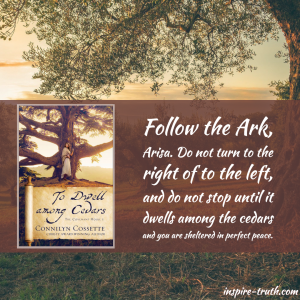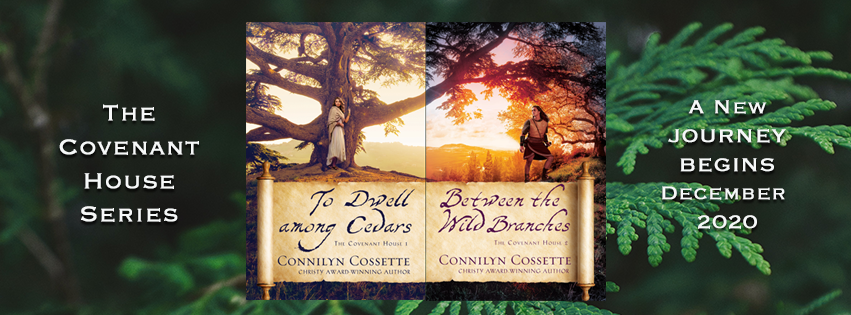
“How marvelous that two enemy children, wild branches by any measure, could—like my father had said—become one with the sons of Avraham. Just as if we were born of the same blood.” ~ Connilyn Cossette
The moment time stands still as you read the last word of a fantastic book is one of the best and worst feelings in the world. Why do all great books come to an end, and why do authors continue to put readers through the hurricanes of their imaginations only to spit us out at the last moment, leaving us to pick up the pieces? In a matter of a few pages, your heart can go from overflowing with love to breaking! Connilyn Cossette’s newest series, The Covenant House, is no exception, though don’t let that dissuade you from embarking on a fabulous new adventure into ancient Israel where Samuel is the judge, the Philistines have won a victory over the Israelites, and the Mishkan (temple) has been destroyed. Introducing the new characters and storyline, To Dwell Among Cedars immediately sweeps readers into its raging waters (literally) before taking them into the eye of the storm and then back into the category two hurricane that will only grow stronger as you get closer to the end.
“Follow the Ark, Arisa. Do not turn to the right of to the left, and do not stop until it dwells among the cedars and you are sheltered in perfect peace.” ~ Connilyn Cossette
Eight years ago, 1070 BC, the Philistines captured the Ark of the Covenant and brought it into the city of Ashdod, throwing it at the feet of Dagon in triumph. However, at the Ark’s presence, the Philistines’ god is thrust to its knees and plagues wash over their land, forcing them to return their prize to the Israelites. At this time, Eliora and her brother, Natan, flee from their family home in Ashdod and follow the Ark of the Covenant into Israelite territory, where they are rescued by a Levite and adopted into Abinidab’s household, whose family was given the charge to protect the Ark.
As the Fall Feast approach and the Levites gather to celebrate, everyone is busy making preparations and organizing the gatherings that will take place. It’s a time to be joyful and festive, yet unrest stirs within the Levitical tribe as they argue over where the Ark of the Covenant should be kept and who is the rightful high priest. Believing Samuel is a false prophet and that the priesthood should return to Eleazar’s line after the devastating defeat at the hands of Eli, son of Itamar, a plan is forged to steal the Ark of the Covenant and take it to where a group of Levites have begun reconstructing the Mishkan.
“No matter what decision I made, the cost would be great. But as my father and brothers had learned the hard way on the field at Afek, the cost of going against the will of the Eternal One was greater by far.” ~ Connilyn Cossette
Returning to Kiryat Yearim, Ronen is at the center of the plot to steal the Ark. Determined to make his uncle proud and fulfill his duty of uncovering the hidden location of the Ark, Ronen is caught off guard when he is reunited with the Philistine girl he saved as a teenager all those years ago. Now grown up, Eliora is radiant and captures Ronen’s attention, testing his loyalties and belief in the mission. Will Ronen and his entourage succeed in their desire to move the Ark? Are they truly fulfilling God’s desire? And, what about Eliora? She’s lived among the Israelites for almost a decade, but has she truly found peace and identity?
“The draw she’d had on me, even from the first time I’d seen her dancing at the wedding, was undeniable. And every moment I’d spent with her since then had felt like the unfurling of something far more precious and rare than the most exotic bloom Eliora had cultivated on this mountain—even when my intentions had been less than honorable.” ~ Connilyn Cossette
A powerful story of adoption, covenant, promise, love, and war, To Dwell Among Cedars not only gives Biblical fiction lovers another amazing story to share with friends but is a narrative that will stay in your mind for days and months to come. I still have not recovered from this novel, and I don’t think I will until the next book is released (July, please hurry!).
To Dwell Among Cedars spoke to my heart and moved me to praise the Father for all the testimonies He has given us. Though this is a story that will entertain, it will also be an inspiration to draw closer to our Creator and learn who He truly is! While thousands walk away from their faith each year, plagued with doubt, I have never been more convinced of Adonai’s realness and presence. Connilyn Cossette did an outstanding job of showing what true faith and servitude looks like, dealing with doubt and identity through protagonists we can all relate to. I loved how each character was given a chance to experience the Holy Spirit, though not everyone accepted this opportunity. Too many authors tend to stay in the New Testament, believing that personal relationships with the Father only began after Yeshua/Jesus’ resurrection, but that’s not true. God has been using His people since the beginning of creation, and Connilyn Cossette never fails to display this in her novels.
If you have never read a novel by Connilyn Cossette and are looking for a thrilling, inspiring, and chain-breaking story that brings the Bible to life, To Dwell Among Cedars is the book for you! If you are familiar with Connilyn’s incredible books, I can assure you that you will not be disappointed by her latest release! Don’t miss your chance to experience Eliora and Ronen’s journeys into the depths of their souls as they discover what it means to be loved and accepted by a God of forgiveness and promise!
CLICK HERE to order a copy of To Dwell Among Cedars
“As an Amazon Associate, I earn from qualifying purchases.”
*Thank you to NetGalley and the publisher for providing me with a pre-release copy of this book. My thoughts and opinions are entirely my own!*
[yasr_multiset setid=0] Ages: 13+
- “Follow the Ark, Arisa. Do not turn to the right of to the left, and do not stop until it dwells among the cedars and you are sheltered in perfect peace.” ~ Connilyn Cossette
- “How marvelous that two enemy children, wild branches by any measure, could—like my father had said—become one with the sons of Avraham. Just as if we were born of the same blood.” ~ Connilyn Cossette
- “No matter what decision I made, the cost would be great. But as my father and brothers had learned the hard way on the field at Afek, the cost of going against the will of the Eternal One was greater by far.” ~ Connilyn Cossette
- “The draw she’d had on me, even from the first time I’d seen her dancing at the wedding, was undeniable. And every moment I’d spent with her since then had felt like the unfurling of something far more precious and rare than the most exotic bloom Eliora had cultivated on this mountain—even when my intentions had been less than honorable.” ~ Connilyn Cossette





